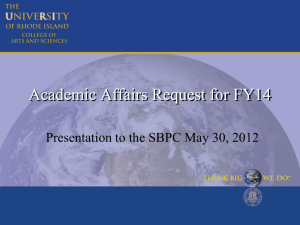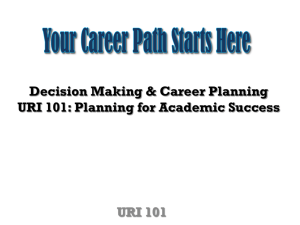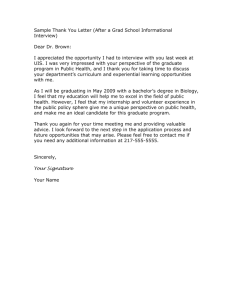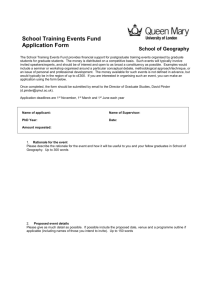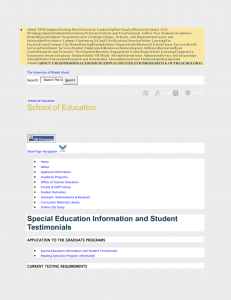SBPC FY2013 Budget Request
advertisement
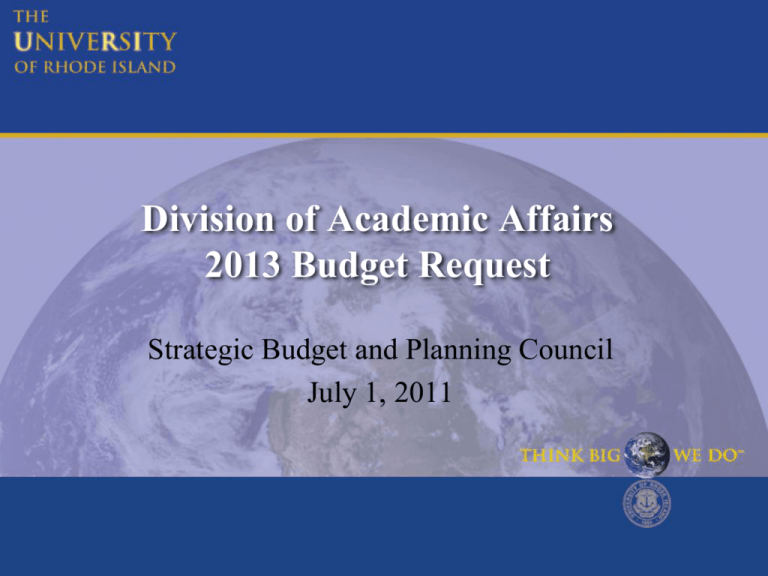
Division of Academic Affairs 2013 Budget Request Strategic Budget and Planning Council July 1, 2011 Budgeting Approaches • Historical approach: non-strategic – – – – Increased enrollments to make up shortfalls–numbers over quality Part-time faculty absorb teaching load for 1st year and gen ed’s Budget reductions – AA absorbs 80% Non-strategic disinvestment in academic core mission • Current approach – Strategic investments contribute to learning and scholarly environment for faculty and students – enhance value – Implement quality and value-added initiatives, while remaining efficient and innovative – Align investments with Academic Plan - Recruit and retain quality students and faculty FY2011 & FY2012 Rationale for Recommendation: 1)Transparent, credible, equitable 2) Significant savings FY11 ($1.1M) Distribute additional funding on the same basis as FY2011 permanent division reductions FY2011 Assigned Budget President Jan 11th Target Actual Departmental Base Reductions % of Total Recommended Restoration of Base Reductions $2.1M $50,000 $50,000 3% $49,449 $154.2M $1,272,24 9 $1,272,249 80% $1,258,224 $30.6M $252,576 $94,576 6% $93,534 Athletics $9.5M $78,402 $78,402 5% $77,538 R & E Dev $0.3M $2,221 $2,221 0% $2,197 Stud Affairs $6.1M $50,086 $50,086 3% $49,534 Univ Adv $5.6M $46,023 $46,023 3% $45,516 $208.4M $1,751,55 7 $1,593,557 $158,000 $1,751,557 Academic Affairs Admin & Fin SUBTOTAL $1,575,992 One time only Priority New Resource Needs for FY 13 1. Strategic Full-Time Faculty Hires 2. Support for Global Strategies: Chief Global Officer 3. Office of Experiential Learning and Community Engagement: Liaisons and Electronic Portal 4. Graduate Research Tuition Differential Fellowship 5. Coordinator of Summer School and Special Programs 1. Strategic Full-Time Faculty Hires Rationale: URI has added more than 4300 FTE students while the number of tenuretrack faculty and lecturers have remained constant 1. Strategic Full-Time Faculty Hires Rationale: URI invests less in instruction than our regional peers Table1. Comparison of Institutional Investments in Instruction on a PerStudent Basis in 2009 and from 2000-2009 Per Student Instruction Investment Institution $ Per Student URI UMASS UNH UVM UMO UCONN $ 6,541 $10,629 $10,249 $12,131 $ 7,405 $20,141 % Increase Over 10 Years 11.5% 33.2% 74.2% 28.5% 19.9% 114.1% 1. Strategic Full-Time Faculty Hires Rationale: URI invests less in instruction than our regional peers Table 2. Proportion of Institutional Budgets Expended on Instruction Institution/Category University of RI RI College New England Land Grants 4-year Publics Instruction Expenditures as % Total 23.6% 33.4% 29.6% 30.1% URI is among the most expensive public doctoral granting institutions in the country with regard to OS tuition, fees, housing, and dining Student to Faculty Ratio Comparisons URI – from 14:1 to 15.5:1 --- target ~16.5:1 UCONN - 18:1 PSU – 17:1 UMASS - 18:1 UILL - 17:1 UNH 19:1 UFL - 22:1 UVM 17:1 UTA - 18:1 URI achieves lower ratio with disproportionate reliance on part-time faculty teaching intro courses 1. Strategic Full-Time Faculty Hires • • • • Total Projected Cost for FY 13: $1.46 million Request FY 13 GF: $1.2 million Academic Affairs Reallocation Cost-Share FY 13: $260,000 “Clusters” of three tenure-track/clinical faculty hires in each of the four thematic areas in the Academic Plan, with interdisciplinary and global emphases: • • • • • • • Health and Wellness Environment and Green Economy Science and Technology Liberal Learning and Scholarship Four full-time lecturers – courses that serve the university broadly Projection for FY 14: 8 tenure-track and 2 lecturers Projection for FY 15: 4 tenure-track and 2 lecturers 2. Support for Global Strategies: Chief Global Officer • • • • • Rationale: Internationalizing URI is a major goal of the Academic Plan and the President’s vision Provide leadership to guide our international strategy, build partnerships and international opportunities for education and research, and increase enrollments of international students Task Force on Global Learning has recommended that the University invest in an office that would integrate efforts across all academic units, and JCAP has endorsed Build on our International Visiting Scholars Program and new ESL program Capture revenue we are now missing (only 41 intl students) 2. Support for Global Strategies: Chief Global Officer • • • • • Total Projected Cost FY 13: $260,000 Request FY 13 GF: $225,000 Academic Affairs Reallocation Cost-Share FY 13: $35,000 This investment would support salary, benefits, support, and operating budget for Global Officer Projection for further investment in global initiatives for FY 14 and FY 15 would come largely from reallocation rather than new general fund requests 3. Office of Experiential Learning and Community Engagement: Liaisons to Academic Units and Electronic Portal • • • • • Rationale: Expanding experiential learning - internships, service learning, projects, and project-based courses – central in the Academic Plan and President’s vision Creation of a “one-stop shop” to support faculty, students, and external constituents in building high quality learning opportunities – Office of Experiential Learning and Community Engagement Key element of student recruitment-retention Development of electronic portal, learning contracts, faculty support, liability releases, funding mechanisms, data hub, link to Rhody-net and Career Services. Key to this initiative is hiring liaisons that would bridge the Office and academic units to support faculty engaged with students in experiential learning 3. Office of Experiential Learning and Community Engagement • • • • • • • Total Projected Cost FY 13: $225,000 Request FY 13 GF: $120,000 Academic Affairs Reallocation Cost-Share FY 13: $40,000 Academic Affairs Soft Money Allocation FY 13: $65,000 Investment would support liaisons to academic units to assist faculty in experiential learning efforts and development of the electronic portal Projection for FY 14: $100,000 Projection for FY 15: $75,000 4. Graduate Research Tuition Differential Fellowship • • • • Rationale: In FY 10 the Fellowship was created to support faculty research and build vibrant graduate programs by providing matching funds to pay the OS and IS tuition differential for graduate research assistantships Successful Program – in FY 11 - $1.15m in grad support Adding investments made in FY 11 and FY 12, the program is now funded at a level of $1.45 million The fully implemented program needs a $2 million investment to support our research and graduate education enterprise 4. Graduate Research Tuition Differential Fellowship • • • • • Total Projected Cost FY 13: $150,000 Request FY 13 GF: $75,000 Overhead Funds FY 13: $75,000 Projection for FY 14: $200,000 Projection for FY 15: $200,000 5. Coordinator of Summer School and Special Programs • • • Rationale: URI’s summer program is unfocused, sessions are underutilized and under-programmed, and online learning opportunities are being missed Better coordination and creativity of summer programs will help us develop and market new offerings, such as fieldbased, experiential, travel, artistic, international, and teacher programs – potential to increase revenue Coordinator would be expected to generate an additional 5% in enrollments resulting in an additional $400,000 in revenues for the summer - thus, position pays for itself 5. Coordinator of Summer School and Special Programs • • • • Total Projected Cost FY 13: $0 Propose funding the position on soft money for FY 13 and 14 as a pilot to determine if we can generate revenue and develop creative new programs Projection for FY 14: $0 Projection for FY 15: $125,000 Summary of Requests for FY 13 • Total General Fund Requests: $1,620,000 • Total Academic Affairs General Fund Budget: $160,000,000 • Percent Increase Requested: 1% Progress over Last 12-15 Months in Strategic Priorities • • • • New budget process was instituted that reflects academic strategic planning and enhances communication among units regarding strategic priorities Process allows for analysis of unit productivity, cost, effectiveness, and innovation Projections are made over three-year horizons that allow us to understand unit needs in the near future With budget constraints and reductions, the most important allocations have been strategic investments in faculty positions Year 2010 2011 2012 aFY Faculty retired/resigned 9 28.5 23 Strategic Reinvestment Faculty Lines 14 39 16a 11 mid-year reduction translated into a base reduction of 8 faculty lines for FY 12. Additional Initiatives within Academic Affairs Other Examples of Reinvestment Graduate Tuition Differential Fellowships Office of Online Teaching and Learning, including – Online Faculty Fellows Program Admissions Staff Enhancement Multicultural Faculty Apprentice Program Grand Challenges course initiative Visiting International Scholars Program Undergraduate Research Fund Graduate Enhancement Fund Digital Classroom Upgrade Faculty Laptop Program Major Capital Investment Requests Find new home for Admissions Office, possibly in Fogarty Hall after Pharmacy moves into its new facility Capital planning will explore alternatives for use of Fogarty in context of institutional priorities
